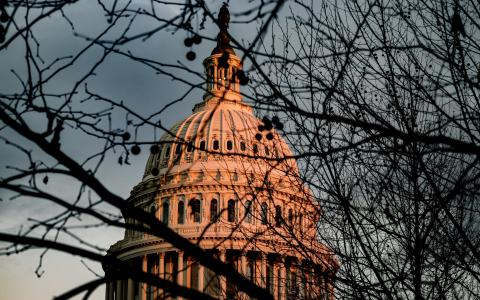
(Bloomberg) - The Federal Reserve’s quantitative-tightening program risks being propelled toward an early end as US politicians bicker in Washington over raising the national debt limit, according to some economists and bond-market participants.


By shrinking its bond portfolio by up to $95 billion a month, the central bank is draining liquidity from the US financial system — complementing its interest-rate hikes in the battle to control inflation. An early end to QT could therefore provide the US economy with some relief.
Through a complex series of reactions, constraints imposed on the Treasury Department by the debt limit could end up amplifying some of the impact of QT later this year.
Commercial bank reserves parked at the Fed form a part of the US financial bedrock, and when the Fed’s first foray with QT caused them to shrink in 2018 and 2019, stocks saw declines and money markets seized up. Dynamics caused by the debt limit could have the effect of a more rapid shrinking of reserves later this year — potentially bringing forward the end of QT, even if the US avoids a default.
“It’s a complicating factor — because we just don’t know how all these things are going to net out against each other,” said Blake Gwinn, head of US rates strategy at RBC Capital Markets. “There’s really two major sources of uncertainty around this process. We don’t know what the right level of reserves is,” nor how long it will take to get there, he said. And the debt limit “adds uncertainty around the pace at which we’re getting to that end level.”
It all makes for a big change from just weeks ago, when the Fed concluded that its bond-portfolio runoff was “proceeding smoothly,” according to minutes of the December policy meeting.
That runoff process can shrink liquidity via two major channels: bank reserves and the so-called reverse repurchase facility, or RRP, which serves as a parking place for money market funds. It can make a difference which one shrinks, because reserves are viewed by economists as having a more powerful role in supporting credit in the economy.
When the Treasury draws down its cash pile and has to start restraining its sales of government securities later this year, there will be less Treasury-bill supply for money market funds. That means they’ll likely need to park more in the reverse-repo facility.
What could then happen is that the other channel affected by Fed QT — bank reserves — end up shrinking faster.
“All of this cash is going to be put to work in the Fed’s RRP facility,” said John Velis, a foreign-exchange and macro strategist at BNY Mellon. “That will bring down reserves, as it’s a mirror image.”
And “if reserves get dangerously low, you could start to see some hiccups” in markets, he warned.
Fed Chair Jerome Powell hasn’t recently offered any update to the central bank’s anticipated QT timeline. He said last July that the Fed’s model suggested it could run for two to 2 1/2 years before bank reserves got down to a “new equilibrium” level after they surged during pandemic-era Fed easing.
Federal Reserve Bank of New York President John Williams said last week that policymakers are taking a look at risks surrounding the debt limit and potential volatility to reserve balances.
“Clearly, those are things that we’re studying, making sure that we think through,” he told reporters. Still, he didn’t anticipate an earlier end to QT than expected, pointing to the surfeit of funds in the RRP facility that can still be worked down. “It’s a process that’s going to take time and obviously we’ll be watching carefully,” he said.
Subadra Rajappa, head of US rates strategy at Societe Generale SA, said that “if money does not begin to flow out of the reverse repo program, as the Fed expects, reserves may become scarce.”
Dallas Fed President Lorie Logan, who previously oversaw balance-sheet management at the New York Fed, noted last week that the Fed’s new standing repurchase facility, which allows firms to borrow cash as needed, could serve as a backstop if reserves suddenly fall too low.
That’s an untested facility, and is subject to caps, but could potentially serve as an early-warning sign of that reserves are getting scarce.
Banks’ reserve balances at the Fed already have dropped by around $900 billion, to around $3.1 trillion. In the near term, they’re likely to see some increase as the Treasury works down its cash balance at the Fed. Once that process is done, they’re likely to resume their decline.
Some Fed watchers had anticipated an end to the bond-portfolio runoff at some point this year even before the latest debt-ceiling drama unfolded. That’s part of a broader debate over whether the Fed will have to abandon monetary tightening and shift toward easing, amid widespread expectations of a recession kicking in.
Tricky Solution
Ironically, what could have an even more powerful impact on bank reserves is an ultimate end to the debt-ceiling impasse. Once the Treasury has a free hand, it’s likely to unleash a massive series of bill sales in order to raise cash — mopping up so much that it could cause a sharp contraction in bank reserves.
T-bill supply could surge by some $500 billion to $800 billion over several months, observers say.
At the same time, reserves may get a boost if banks begin to compete more intensely for deposits, drawing cash away from money funds and the reverse repo facility, said Derek Tang, an economist with LH Meyer who expects QT to last until 2024. It’s a scenario more Fed officials have pointed to in the past week.
“The Fed seems more confident that the market will do the job of redistributing liquidity where it’s needed,” said Tang.
By Liz Capo McCormick and Jonnelle Marte



